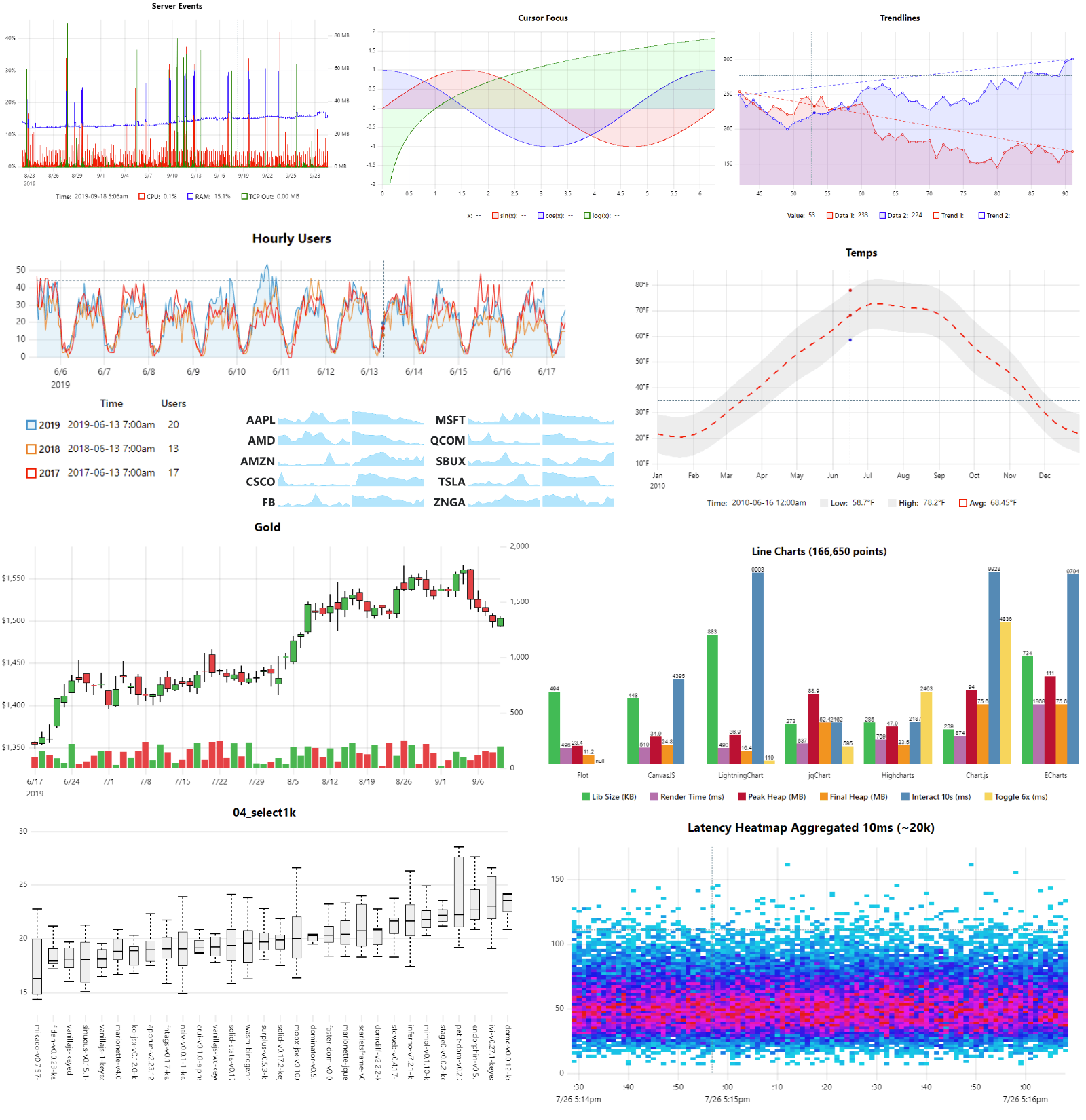@aliyun-sls/uplot v1.6.17
📈 μPlot
A small (~40 KB min), fast chart for time series, lines, areas, ohlc & bars (MIT Licensed)
Introduction
μPlot is a fast, memory-efficient Canvas 2D-based chart for plotting time series, lines, areas, ohlc & bars; from a cold start it can create an interactive chart containing 150,000 data points in 135ms, scaling linearly at ~25,000 pts/ms. In addition to fast initial render, the zooming and cursor performance is by far the best of any similar charting lib; at ~40 KB, it's likely the smallest and fastest time series plotter that doesn't make use of context-limited WebGL shaders or WASM, both of which have much higher startup cost and code size.
However, if you need 60fps performance with massive streaming datasets, uPlot can only get you so far. WebGL should still be the tool of choice for applications like realtime signal or waveform visualizations: See danchitnis/webgl-plot, huww98/TimeChart, epezent/implot, or commercial products like LightningChart®.

Features
- Multiple series w/toggle
- Multiple y-axes, scales & grids
- Temporal or numeric x-axis
- Linear, uniform or logarithmic scales
- Line & Area styles (stroke, fill, width, dash)
- Pluggable path renderers linear, spline, stepped, bars
- Zoom with auto-rescale
- Legend with live values
- Support for IANA Time Zone Names & DST
- Support for missing data
- Cursor sync for multiple charts
- Focus closest series
- Data streaming (live update)
- High / Low bands
- A lean, consistent, and powerful API with hooks & plugins
Non-Features
In order to stay lean, fast and focused the following features will not be added:
- No data parsing, aggregation, summation or statistical processing - just do it in advance. e.g. https://simplestatistics.org/, https://www.papaparse.com/
- No transitions or animations - they're always pure distractions.
- No collision avoidance for axis tick labels, so may require manual tweaking of spacing metrics if label customization significiantly increases default label widths.
- No stacked series: see "Stacked Area Graphs Are Not Your Friend" and a horrific demo. While smooth spline interpolation is available, its use is strongly discouraged: Your data is misrepresented!. Both visualizations are terrible at accurately communicating information.
- No built-in drag scrolling/panning due to ambiguous native zoom/selection behavior. However, this can be added externally via the plugin/hooks API: zoom-wheel, zoom-touch.
Documentation (WIP)
The docs are a perpetual work in progress, it seems. Start with /docs/README.md for a conceptual overview. The full API is further documented via comments in /dist/uPlot.d.ts. Additionally, an ever-expanding collection of runnable /demos covers the vast majority of uPlot's API.
Third-party Integrations
- Jupyter widget (Sohail Somani)
- React and Vue.js (Sergey Kalinichev)
Performance
Benchmarks done on this hardware:
- Date: 2021-04-24
- Windows 10 x64, Chrome 90.0.4430.85 (64-bit)
- Core i7-8700 @ 3.2GHz, 16GB RAM
- AMD Radeon RX480, 2560x1440 res

Full size: https://leeoniya.github.io/uPlot/demos/multi-bars.html
Raw data: https://github.com/leeoniya/uPlot/blob/master/bench/results.json
Normally, all libs are updated to their latest versions before each benchmark round. However, libraries which show significant performance improvements in latest versions will have prior versions shown to encourage migration; this is especially true for still-widely-deployed libs, such as Chart.js v2.9.4, and ECharts v4.9.0. Deployment prevalence is assessed from public npm and CDN download stats for the prior few months.
- libs are sorted by their initial, cold-start, render performance (excluding network transfer time to download the lib)
sizeincludes the lib itself plus any dependencies required to render the benchmark, e.g. Moment, jQuery, etc.- Flot does not make available any minified assets and all their examples use the uncompressed sources; they also use an uncompressed version of jQuery :/
Some libraries provide their own performance demos:
- https://echarts.apache.org/next/examples/en/index.html
- https://github.com/sveinn-steinarsson/flot-downsample/
- https://dygraphs.com/tests/dygraph-many-points-benchmark.html
- https://www.chartjs.org/docs/latest/general/performance.html
- https://dash.plotly.com/performance
- https://www.highcharts.com/docs/advanced-chart-features/boost-module
- https://danchitnis.github.io/webgl-plot-examples/vanilla/
- https://huww98.github.io/TimeChart/docs/performance
- https://www.arction.com/lightningchart-js-performance/
TODO (all of these use SVG, so performance should be similar to Highcharts):
- Chartist.js
- d3-based
- C3.js
- dc.js
- MetricsGraphics
- rickshaw
Acknowledgements
- Dan Vanderkam's dygraphs was a big inspiration; in fact, my stale pull request #948 was a primary motivator for μPlot's inception.
- Adam Pearce for #15 - remove redundant lineTo commands.
4 years ago